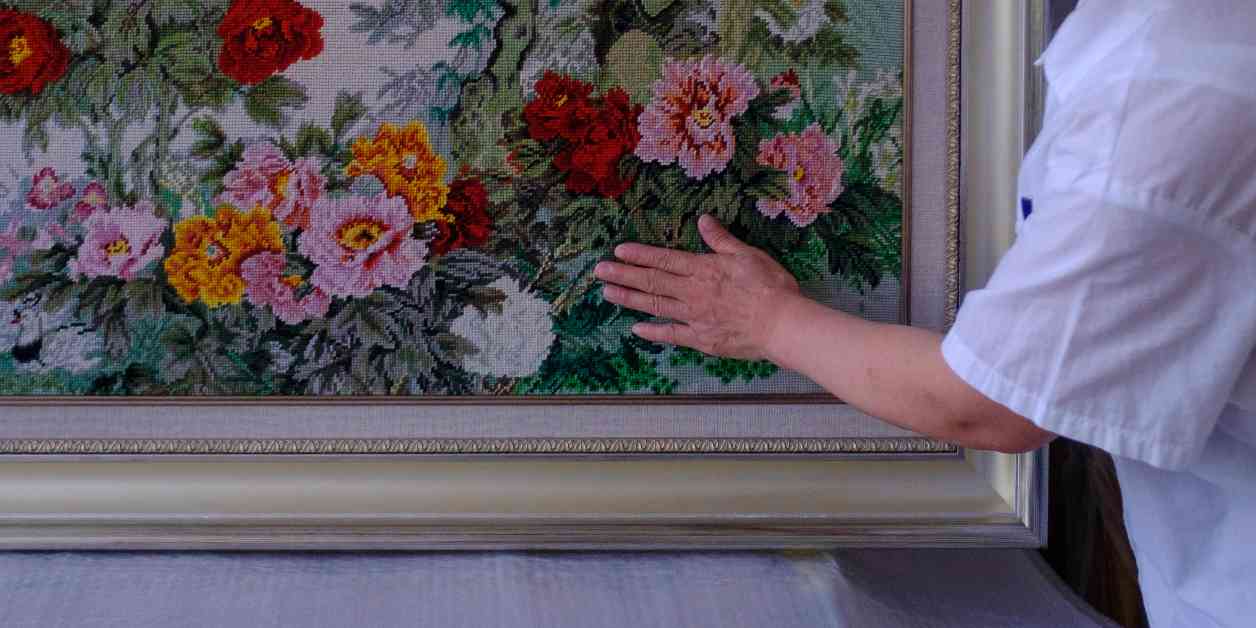SHANGHAI – Life took an unexpected turn for Yan when she received the news from her lawyer that she would be sentenced to life in prison for drug smuggling. Overwhelmed with fear and anxiety, she entered the courtroom on the day of her trial in 2019, her body trembling with nerves. “At that moment, I felt I was finished, my life was over,” Yan, 66, recalls at Nanhui Prison in Shanghai. Using a pseudonym to protect her privacy, she describes feeling “hopeless and worthless” at the beginning of her prison life. However, her perspective began to shift a few months later when she joined a woolen needlepoint tapestry class. “I found a new world full of color; it saved me,” she says.
Art as Therapy and Skill Development
Yan has since become one of the jail’s five most proficient tapestry artists, spending three hours in the morning and afternoon perfecting her skills. Woolen needlepoint tapestry has been integrated into an innovative education program at Nanhui Prison since 2018. The program’s objectives include teaching inmates artistic skills, enhancing their mental well-being, and preparing them for reintegration into society. Over the past six years, inmates at the prison have collectively created over 100 tapestry works.
China’s Prison System and Art Programs
As of 2018, China had 680 prisons housing more than 1.7 million prisoners. While art programs are common in Chinese prisons, Shanghai stands out as one of the first to incorporate “intangible cultural heritage,” referring to traditional arts and crafts practices deemed worthy of protection by the government. Shanghai’s commitment to promoting these programs is evident in the Mass Art Museum’s exhibition, which featured over 250 pieces from intangible cultural heritage projects in 15 detention facilities, including tapestry embroidery from Nanhui Prison.
Nanhui Prison’s Unique Approach
Nanhui Prison caters to elderly, sick, and disabled inmates, with Cell Block Seven specifically designed for female offenders, whose average sentence is around eight years. Xu Wenying, the chief warden of Cell Block Seven, notes that most inmates in this block are over 60 years old, many of whom are disabled or in poor health. Primarily serving time for economic crimes related to seeking quick financial gains, inmates in this block are encouraged to participate in activities like embroidery to foster character improvement and patience.
The Therapeutic Benefits of Tapestry Embroidery
Shanghai woolen needlepoint tapestry involves stitching colored woolen threads on a net-like fabric, a craft introduced to Shanghai from Italy in the early 20th century. The vibrant colors and artistic flair of this craft capture elements of traditional Chinese oil paintings, with a single image often comprising tens of thousands of meticulous stitches. Larger-scale embroidery projects promote teamwork skills and positive relationships within the inmate community, providing a sense of connection to the nation’s history through pieces like the commemorative “Red Boat” celebrating the 70th anniversary of the founding of the People’s Republic of China.
Challenges and Exclusions in Tapestry Embroidery
Not all inmates are eligible to participate in embroidery, as violent offenders are excluded due to safety concerns regarding the use of sharp tools. Inmates with recent demerits are also not permitted to learn embroidery, as it is considered a reward, and the time spent on this activity contributes to mandatory labor hours. While the embroidery project offers the potential for sentence reductions based on performance, challenges such as delayed material supply and the difficulty of mastering technical skills persist. Additionally, finding employment post-release can be challenging for former inmates, particularly due to their age and limited job opportunities.
Inmate Success Stories and Future Aspirations
Despite the challenges, individuals like Cheng, a skilled embroiderer at Nanhui Prison, have found success and fulfillment through their dedication to the craft. Serving a reduced sentence for good behavior, Cheng initially struggled with basic needlework but has since created impressive tapestries reflecting her growth and creativity. Sharing her expertise with fellow inmates, Cheng hopes to leave behind a final piece before her release and pursue opportunities in media or entrepreneurship centered around her embroidery skills. Another inmate, Yan, finds solace and accomplishment in her artwork, with aspirations for a commuted sentence and a brighter future beyond prison walls.
Impact of Art Programs on Inmate Rehabilitation
Prison art programs play a crucial role in facilitating inmate rehabilitation and successful reintegration into society by providing valuable skills and fostering hope for the future. The focused and meditative process of embroidery can help alleviate psychological pressure and create a sense of purpose and accomplishment for participants. While challenges remain, such as mastering complex techniques and securing employment post-release, the transformative power of art within the prison system is undeniable.
Looking Ahead: The Future of Inmate Art Programs
As the demand for effective rehabilitation programs grows, there is a need for continued support and resources to help former inmates transition back into society successfully. Zhang Xiaoye, a criminology lecturer, emphasizes the importance of preparing inmates for post-release employment opportunities, highlighting the need for comprehensive support beyond skills training. With dedicated educators like Bao Yanhui collaborating with prisoners to nurture their artistic talents, there is potential for further growth and innovation within prison art programs, paving the way for a more hopeful and fulfilling future for inmates like Yan and Cheng.
In Conclusion
In the midst of confinement and adversity, inmates at Nanhui Prison in Shanghai have found solace, skill development, and a sense of purpose through woolen needlepoint tapestry embroidery. As they navigate the challenges of prison life, these individuals are transforming their experiences through art, forging connections, and cultivating hope for the future. Through innovative programs and dedicated mentors, inmates are not only honing their artistic abilities but also rediscovering their sense of self-worth and resilience. As they continue their journey towards rehabilitation and reintegration, their stories serve as a testament to the transformative power of art within the prison system.

















